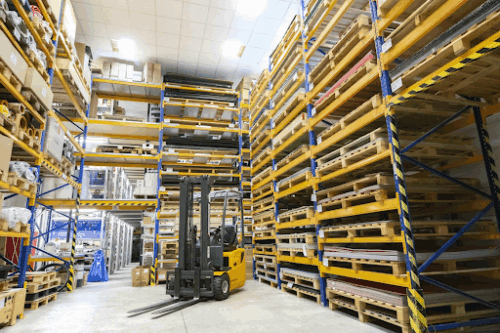Digital Twins in Logistics: What They Are, How They Work, and Benefits

Digital twins in logistics turn live data into smart decisions. These models improve planning, boost speed, and raise accuracy across modern supply chain management strategies.
Digital twins in logistics are virtual replicas of supply chain systems that mirror real-world scenarios. These models help logistics teams visualize, monitor, simulate, and improve actual operations using real-time data, predictions, and smart analytics.
From distribution centers to logistics networks, every component gets mapped digitally to support better planning. By using real-time data, predictive analytics, and digital twin technology, businesses boost supply chain efficiency and gain real-time visibility into their logistics operations.
What Are Digital Twins in Logistics?
Digital twins in logistics are virtual models of real-world supply chain networks. Each digital twin provides key parts of supply chain operations, such as warehouses, vehicles, production lines, and inventory flows. These replicas help companies run system testing and monitor performance without disrupting daily business operations.
Real-time data from sensor data, GPS, and warehouse operations feeds into the digital twin model. That flow allows businesses to simulate, predict, and improve responses to changing customer demand or supplier delays.
How Digital Twins Work in Logistics
Digital twin technology runs on a mix of IoT sensors, cloud computing, AI technology, and predictive analytics. These enabling technologies help logistics teams collect and process live inputs from trucks, facilities, and tools.

Companies use this data to create digital twins that reflect everything happening across the supply chain, including inventory levels, production lines, warehouse operations, and transportation flows, enabling smarter, faster, and more accurate decisions.
From tracking energy consumption in distribution centers to forecasting inventory levels, each part gets mapped to a virtual environment. These twins respond to various scenarios and support critical decision-making.
AI-powered tools analyze patterns in traffic patterns, raw materials usage, or equipment failures. Businesses use these insights to avoid delays, cut costs, and improve operational efficiency across logistics networks.
Benefits of Digital Twins in Supply Chains
Digital twins improve logistics visibility, accuracy, and response time across all parts of supply chain management. Here are the key benefits of digital twins in supply chains:
- Improve real-time visibility into logistics operations: Live updates from sensor data allow teams to detect slowdowns, reroute shipments, and improve supply chain visibility across hubs.
- Optimize delivery routes and transportation networks: Virtual modeling of traffic patterns and fuel usage cuts travel time and helps logistics teams build smarter, more efficient supply chain networks.
- Reduce downtime through predictive maintenance: Early warnings from AI technology help fix potential equipment failures before they cause disruption to the supply chain digital workflow.
- Support warehouse efficiency and inventory accuracy: Digital twins improve warehouse management by streamlining layout, reducing congestion, and helping maintain correct inventory levels.
- Enhance demand forecasting: Forecast tools inside the digital twin system use historical data and customer demand trends to adjust for seasonal changes or unexpected surges.
- Enable proactive risk mitigation: Simulations test what-if scenarios like natural disasters or labor shortages, helping teams prepare backup plans and reduce delays.
- Facilitate faster, data-driven decision-making: Leaders get access to valuable insights in real time, improving reactions to market shifts and enhancing supply chain optimization.
Improved control, accurate forecasting, and real-time adjustments combine to raise overall supply chain efficiency across the board.
Applications Across Logistics Functions
DT in logistics brings real value to core operations. These models work across functions, offering real-time updates, sharper planning, and smarter reactions across every part of logistics. The following are the applications of digital twins across industries:
Warehouse Management
Digital twins improve warehouse operations by simulating storage layout, traffic flow, and labor use. Managers fix bottlenecks, speed up picking, and track inventory levels in real time. Better design reduces congestion and supports smoother order fulfillment while improving space use and cutting waste.

Transportation and Routing
Virtual models of transport routes help teams test delivery plans, adjust for traffic, and avoid delays. Using advanced analytics, companies optimize processes, lower fuel use, and improve timing. These simulations boost customer satisfaction and support ongoing cost reduction for growing logistics operations.
Inventory and Demand Forecasting
Digital twins support smarter inventory management by modeling customer demand and predicting sales trends. This helps avoid both shortages and excess stock. Forecasts support optimizing inventory levels, which improves turnover, reduces waste, and helps maintain better margins across every link in the supply chain.
Supply Chain Disruption Management
Simulating what-if scenarios like port closures, weather issues, or strikes helps teams prepare backup plans. Digital twins help reduce downtime by giving clear, quick responses. This approach supports stronger supply chain resilience, improves planning, and ensures fewer surprises across supply chain operations.
Considerations for Adopting Digital Twins
Digital twin success starts with smart planning. Businesses need a phased strategy, clear data goals, and the right people to unlock full value from these transformative technology tools. Understand these potential considerations:
- Investment in IoT and data infrastructure: Strong digital twins rely on sensors, connectivity, and cloud tools. Businesses need the right base to gather accurate data and build real-time models for complex logistics operations.
- Integration with existing ERP and WMS systems: Connecting digital twins with current systems ensures a better flow of data. Smoothly integrating data keeps everything updated and improves system-wide visibility and response times.
- Access to skilled data analysts and logistics professionals: Trained experts help interpret data, run scenarios, and guide actions. Emulate human capabilities to unlock the full benefits of digital twin technology.
- Managing cybersecurity and data privacy: Real-time models hold sensitive info. Teams must follow strict controls to keep systems secure and ensure full privacy within the digital twin’s environment.
- Developing KPIs to track performance improvements: Setting clear goals helps track gains in speed, savings, and service. Useful KPIs show where digital twins offer the most value and where to improve further.
Conclusion
Digital twins in logistics turn live data into smart decisions. These models improve planning, boost speed, and raise accuracy across modern supply chain management strategies. Tools like these help avoid delays and improve service.
Any business can start implementing digital twin technology using digital twins to unlock real gains in supply chain optimization, improve agility, enhance process optimization, and support smarter, faster supply chain operations.
With the right tools and planning, teams can get faster, smarter, and more flexible every step of the way.
